Reflections
Interviews conducted by members of the OALA Legacy Task Force and the Ground Editorial Board
Past Presidents of the OALA and senior practitioners reflect on the past, present, and future of landscape architecture, and share their thoughts on the professional milestones of their careers.
BIOS/
VIRGINIA BURT, OALA, FCSLA, FASLA, PRINCIPAL OF VIRGINIA BURT DESIGNS INC., SPECIALIZES IN HEALING LANDSCAPES AND GARDENS, LABYRINTHS, AND SACRED SPACES FOR PRIVATE RESIDENTIAL, EDUCATIONAL, AND HEALTHCARE CLIENTS. HER WORK HAS ACHIEVED INTERNATIONAL RECOGNITION FOR MASTER PLANNING, PRIVATE GARDENS, AND PUBLIC HEALTHCARE PROJECTS, RECEIVING MULTIPLE NATIONAL AWARDS FROM THE AMERICAN SOCIETY OF LANDSCAPE ARCHITECTS (ASLA), PALLADIO, AND THE CANADIAN SOCIETY OF LANDSCAPE ARCHITECTS (CSLA). VIRGINIA’S WORK CREATES LANDSCAPES THAT REVEAL THEIR NATURAL CONTEXT AND REFLECT THOSE WHO USE THEM, DEMONSTRATING HER DEEP RESPECT FOR PLACE AND FOR THE HUMAN DIMENSIONS OF EACH PROJECT.
ED HOLUBOWICH, OALA (EMERITUS), FCSLA, WORKED FOR THE NATIONAL CAPITAL COMMISSION (NCC) FOR 28 YEARS, SERVING AS CHIEF LANDSCAPE ARCHITECT FOR 18 YEARS. THE NCC HAS THE RESPONSIBILITY AND AUTHORITY FOR THE PLANNING, DESIGN, DEVELOPMENT, AND MAINTENANCE IN PERPETUITY OF ALL FEDERALLY OWNED LANDS IN THE NATIONAL CAPITAL REGION. IT IS WITHIN THIS CONTEXT THAT ED, AS CHIEF LANDSCAPE ARCHITECT, WAS REQUIRED TO PLAN, ORGANIZE, AND COORDINATE THE NCC’S LANDSCAPE DEVELOPMENT PROGRAM. HE WAS ALSO RESPONSIBLE FOR MONITORING COMPLIANCE WITH AND IMPLEMENTATION OF THE RECOMMENDATIONS OF NCC’S ADVISORY COMMITTEE ON DESIGN AS THEY RELATED TO LANDSCAPE AND URBAN DESIGN. PROVIDING DIRECTION AND LEADERSHIP FOR UP TO 15 PROFESSIONAL AND TECHNICAL STAFF, ED WAS RESPONSIBLE AND ACCOUNTABLE FOR AN EXTREMELY DIVERSE SCOPE OF DESIGN STUDIES AND PROJECTS, SUCH AS THE MASTER PLANS FOR GATINEAU PARK AND THE GREENBELT, AND SITE PLANNING AND DEVELOPMENT OF THE PARLIAMENTARY PRECINCT.
SINCE 1998, LINDA IRVINE, OALA, FCSLA, HAS BEEN MANAGER, PARKS AND OPEN SPACE DEVELOPMENT AND HAS BEEN RESPONSIBLE FOR OVERSEEING, MANAGING, AND COORDINATING ALL NEW PARK DEVELOPMENT WITHIN THE CITY OF MARKHAM, AS WELL AS MANAGING SELECTED URBAN DESIGN PROJECTS FOR THE MUNICIPALITY. PRIOR TO 1998, LINDA SERVED AS A FACULTY MEMBER IN LANDSCAPE ARCHITECTURE AT THE UNIVERSITY OF TORONTO, THE UNIVERSITY OF ILLINOIS AT URBANA-CHAMPAIGN, VIRGINIA POLYTECHNIC INSTITUTE AND STATE UNIVERSITY, AND THE UNIVERSITY OF GUELPH. SINCE THE 1990S, SHE HAS BEEN ACTIVE IN THE OALA, SERVING AS A MEMBER OF COUNCIL AS APPOINTED EDUCATOR, VICE-PRESIDENT, PRESIDENT (2005-2007), AND PAST-PRESIDENT (2007-2009). SHE HAS ALSO SERVED ON THE CSLA BOARD OF DIRECTORS AS PRESIDENT-ELECT (2008-2009); PRESIDENT (2009- 2010); AND PAST- PRESIDENT (2010-2011). CURRENTLY, SHE IS CHAIR OF THE COLLEGE OF FELLOWS.
BRAD JOHNSON, OALA (EMERITUS), FCSLA, EARNED HIS BLA FROM THE UNIVERSITY OF ILLINOIS IN 1958 AND HIS MLA FROM HARVARD IN 1963. HE WORKED FOR PROJECT PLANNING ASSOCIATES FROM 1958 INTO THE 1960S. IN 1966, WITH A PLANNER AND ENGINEER, HE CO-FOUNDED JOHNSON SUSTRONK WEINSTEIN & ASSOCIATES LIMITED (SOLD TO ASSOCIATES IN 1987). HE FOUNDED B J + ASSOCIATES IN 1987. HIS WORK INCLUDED PLANNING AND DESIGN FOR ALL LEVELS OF GOVERNMENT, INSTITUTIONS, AND THE PRIVATE SECTOR IN CANADA AND ABROAD. HE WAS A VISITING TEACHER IN CANADA, THE U.S., AND AUSTRALIA. JOHNSON IS PAST PRESIDENT AND FELLOW OF THE CSLA AND ACADEMICIAN OF THE RCA.
WALTER KEHM, OALA (EMERITUS), FCSLA, HAS HAD A LIFE-LONG INTEREST IN THE INTEGRATION OF NATURE WITH CITIES AND COMMUNITIES. AFTER HIS UNIVERSITY EDUCATION AT SYRACUSE AND HARVARD, HE BEGAN HIS PRACTICE AT PROJECT PLANNING ASSOCIATES IN 1965. FOLLOWING HIS TIME AT THE FIRM, HE TAUGHT AT HARVARD’S GRADUATE SCHOOL OF DESIGN AND, WHEN HE RETURNED TO TORONTO, STARTED THE FIRM EDA COLLABORATIVE WITH THREE COLLEAGUES. IN 1986, HE WAS APPOINTED DIRECTOR OF THE SCHOOL OF LANDSCAPE ARCHITECTURE AT THE UNIVERSITY OF GUELPH, WHERE HE REMAINED UNTIL HIS RETIREMENT IN 2000. SINCE THEN, HE HAS BEEN A SENIOR PRINCIPAL WITH LANDINC AND RECENTLY COMPLETED TRILLIUM PARK AT ONTARIO PLACE. HE CONTINUES TO PRACTISE ON A PART-TIME BASIS WITH COMMISSIONS IN EGYPT, SOUTH AFRICA, AND CANADA.
STEVE MOORHEAD, OALA (EMERITUS), FCSLA, RECEIVED HIS BLA FROM PENN STATE UNIVERSITY IN 1962 AND HIS MLA FROM THE UNIVERSITY OF MICHIGAN IN 1963. HIS FIRST JOB IN TORONTO WAS AT SASAKI STRONG IN 1964. MAJOR PROJECTS HE HAS WORKED ON INCLUDE MCMASTER UNIVERSITY; YORK UNIVERSITY; EXPO 67; GROS MORNE NATIONAL PARK; FATHOM FIVE PROVINCIAL PARK; WRITING ON STONE PROVINCIAL PARK; RYERSON COMMUNITY PARK; CBC HEADQUARTERS PARK; MUSKOKA WHARF; AND CANADA’S WONDERLAND. A FOUNDING PARTNER OF FORREC IN THE 1980S, STEVE HAS DESIGNED THEME PARKS IN COUNTRIES AROUND THE WORLD.
CECELIA PAINE, OALA, FCSLA, FASLA, RECENTLY RETIRED FROM THE UNIVERSITY OF GUELPH, WHERE SHE HAD BEEN ON FACULTY SINCE 1990. PRIOR TO THAT, SHE PRACTISED IN OTTAWA; HER FIRM FOCUSED ON URBAN DESIGN, HERITAGE CONSERVATION, URBAN PARK DESIGN, AND OPEN-SPACE PLANNING. ACTIVE IN PROFESSIONAL ORGANIZATIONS, CECELIA SERVED AS PRESIDENT OF THE CANADIAN SOCIETY OF LANDSCAPE ARCHITECTS AND THE OALA AND WAS FOUNDING EDITOR OF LANDSCAPES/PAYSAGES. SHE CURRENTLY SERVES ON THE BOARD OF THE LANDSCAPE ARCHITECTURE CANADA FOUNDATION AND IS A MEMBER OF THE NATIONAL CAPITAL COMMISSION ADVISORY COMMITTEE ON PLANNING, DESIGN AND REAL ESTATE.
OWEN SCOTT, OALA (EMERITUS), FCSLA, SERVED AS PRESIDENT OF BOTH THE OALA (1973-1975) AND THE CSLA (1976-1978). HE IS A GRADUATE OF THE UNIVERSITY OF GUELPH AND THE UNIVERSITY OF MICHIGAN; WAS A PROFESSOR IN GUELPH’S SCHOOL OF LANDSCAPE ARCHITECTURE (1969-1982); EDITED AND PUBLISHED LANDSCAPE ARCHITECTURE CANADA (1975-1981), THE CSLA’S QUARTERLY MAGAZINE; WAS A SECRETARY-TREASURER OF THE CSLA COLLEGE OF FELLOWS (1979-1989); WAS A MEMBER OF THE CSLA ACCREDITATION COUNCIL; WAS CHAIR OF THE CITY OF GUELPH’S LACAC (NOW HERITAGE GUELPH); WAS DIRECTOR OF THE CANADIAN ASSOCIATION OF HERITAGE PROFESSIONALS; WAS A LANDSCAPE ARCHITECT WITH PROJECT PLANNING ASSOCIATES LIMITED (1964-1969) AND PRINCIPAL WITH THE PACIFIC LANDPLAN COLLABORATIVE LTD. (1977-1986) AND THE LANDPLAN COLLABORATIVE LTD. (1977-2018).
CAROLYN WOODLAND, OALA, FCSLA, MCIP, RPP, JOINED THE TORONTO AND REGION CONSERVATION AUTHORITY (TRCA) FOLLOWING 25 YEARS OF PRIVATE PRACTICE WITH HOUGH STANSBURY WOODLAND, LATER HWNDL, WHERE SHE WAS A MANAGING PARTNER. IN HER CURRENT TRCA POSITION AS SENIOR DIRECTOR, PLANNING & DEVELOPMENT, SHE HAS OVERSEEN THE ENVIRONMENTAL PLANNING, DEVELOPMENT REVIEW, POLICY, AND ENVIRONMENTAL ASSESSMENT FUNCTIONS WITHIN 18 MUNICIPALITIES IN THE TORONTO REGION. CAROLYN’S SIGNIFICANT WORK HAS HELPED TO PROTECT ONTARIO’S FUTURE BY DEFINING PLANS TO MANAGE GROWTH, PROTECT AND ENHANCE GREENSPACE, PROTECT WATERSHEDS, AND FOCUS ON CLIMATE CHANGE. HER 40-YEAR CAREER IS FOUNDED ON A PASSIONATE ADVOCACY FOR INTEGRATING DESIGN AND SCIENCE FOR A VIBRANT PUBLIC REALM—EMBEDDED IN HER AWARD-RECOGNIZED CONSULTING, ACADEMIC TEACHING (UNIVERSITY OF TORONTO), AND PUBLIC SERVICE.
ROB WRIGHT, OALA, FCSLA, HAS A BSC FROM THE UNIVERSITY OF OTTAWA AND AN MLA FROM THE UNIVERSITY OF GUELPH. A PROFESSOR AT THE UNIVERSITY OF TORONTO’S JOHN H. DANIELS FACULTY OF ARCHITECTURE, LANDSCAPE, AND DESIGN, HIS WORK IS INTERDISCIPLINARY AND ECLECTIC IN NATURE. HE IS ALSO THE PRINCIPLE OF IZ, AN OPEN AND EXPLORATORY DESIGN PRACTICE THAT SEEKS TO DEVELOP CREATIVE DESIGN EXPERIMENTATION IN MANY DISCIPLINES, INCLUDING LANDSCAPE ARCHITECTURE, FASHION, FURNITURE, ART, AND THE INDUSTRIAL ARTS. ROB IS THE DIRECTOR OF THE CENTRE FOR LANDSCAPE RESEARCH, BRINGING THE UNIVERSITY OF TORONTO’S EXPERTISE TOGETHER WITH COMMUNITY, INDUSTRY, AND GOVERNMENT RESEARCH INTERESTS. HE IS ALSO AN ASSOCIATE OF THE CITIES CENTRE AT THE UNIVERSITY OF TORONTO AND CROSS-APPOINTED WITH U OF T’S DEPARTMENT OF GEOGRAPHY.
The following text excerpts are from video interviews conducted by the OALA’s Legacy Task Force and from email, phone, and in-person interviews conducted by members of the Ground Editorial Board. View the full video interviews at the bottom of this article.
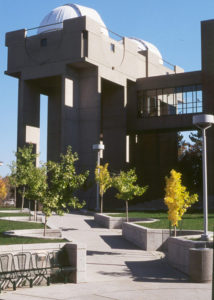
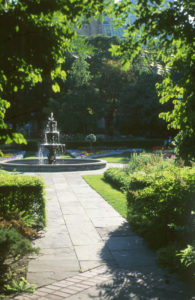
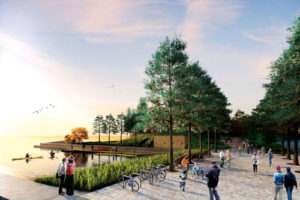
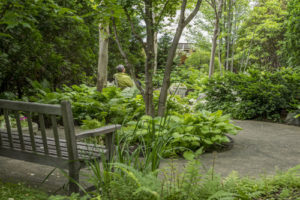
Turning Points:
Owen Scott: The founding of the OALA in 1968 was a turning point because it was the first time in the province that landscape architects had a collective voice. The CSLA existed from 1934, but it was a national organization, not a local organization. The OALA became that strong collective local voice, though it wasn’t really provincial—it was really just two cities, Ottawa and Toronto. Nonetheless, that voice was the turning point for landscape architects.
Almost no municipalities had landscape architects on staff back in 1968. CMHC (Canada Mortgage and Housing Corporation) and the National Capital Commission(NCC) were probably the only public agencies that had landscape architects on staff. After the OALA was founded, and with the students that came out of the University of Guelph and the University of Toronto, landscape architects started to be engaged by municipalities. Most of them weren’t called landscape architects, they were called park planners, but they were landscape architects nonetheless. That was a real turning point because that meant that these young people who had all kinds of great ideas were now in positions of responsibility and authority, so they could engage landscape architects to do the work that municipalities were doing. With students graduating from Guelph and Toronto, we didn’t need to import land- scape architects anymore. As a matter of fact, we now export landscape architects. Many of my students have ended up in the States. They’re all over the world.
Linda Irvine: For me, the most important turning point for the profession was in November 2005 when in my capacity as President of the OALA, the membershipratified changes to the bylaws that govern membership entrance requirements including education, experience, and examination requirements. These bylaw changes to membership entrance options reconciled the expanding range of activities and areas of practice within landscape architecture with OALA’s legislative responsibilities to serve and to protect the public interest. The bylaw changes provided for full membership with “Certificate and Seal” and full membership with “Certificate only.”
These bylaw changes acknowledged the full breadth and depth of the profession by setting appropriate membership standards and examination requirements to permit the use of the title landscape architect by individuals who practise within all areas of the ever-expanding profession. As such, these changes provided the opportunity for professional status, recognition, and representation for those practising in non-traditional and emerging areas of the profession, including those that may not result in built works, as well as those who provide traditional landscape architectural design, construction, and contract administration services.
Ed Holubowich: I believe that my most important contribution was to conceive and develop standard details for the concept of Cluster Campground Units based on the pinwheel principle. Traditionally, until then, campsites were located along the sides of long, winding roadways—always noisy and dusty. This new system, using aerial topographic survey mapping along with site reconnaissance, allowed more efficient and coherent use of available usable level-land areas, while decreasing roadway construction, increasing campsite density, and with greater conservation of existing vegetation offering more privacy and camping pleasure.
During this time, landscape architects did not have professional status in the federal public service. We were hired as technical officers, receiving much less pay than architects, city planners, and engineers. To correct this unfairness, with the help of colleague Peter Coe, we prepared a report to be submitted to federal Treasury Board officials. It contained a brief history of our profession, educational requirements to graduate, a description of work done by landscape architects, the code of ethics, and professional practice standards. After several meetings with the Board, our efforts paid off. By the mid 1970s, federally employed landscape architects received professional classification and commensurate compensation with parity to the other professions. This was a benchmark achievement that may have had a ripple effect on other levels of government employing landscape architects.
Carolyn Woodland: My years at the University of Toronto with teachers such as Ed Fife, Richard Strong, Bill Rock, and Gerry Englar were stimulating and rich in a studio culture that always nurtured great debate, excellence in our design endeavours, and a sense of mission that grew out of our varied project explorations and the exemplary leadership of our mentors. I will always be so grateful for a scholarship in my third year at school that landed me in the office of Hough Stansbury + Associates. They supported a young woman in the office at a time when these positions were rare, and they never let me down in their encouragement. Although I only drafted and prepared presentation graphics for two years before I was given any project, I soaked up the dynamic projects of a firm that already had a well-known urban design reputation in Toronto but was also building a resource management reputation with a full team of biologists and field scientists. This new team worked side by side within a multidisciplinary team of landscape architects, architects, and planners—a completely unique style of office for 1976.
My career spanned 25 years with this groundbreaking consulting firm, working across Canada and even to a few selected international locations. The leadership in design and ecological management was masterful with Michael Hough and James Stansbury in the early years. Huff and Puff, as the firm was nicknamed, became a firm with an ideology about linking science and design—a foundation of “design with nature.”
Walter Kehm: The founding bases for the OALA were: health, welfare, and public safety. These were the pivotal issues of why we should be a self-regulating profession. If we don’t get to the roots of why we are professionals, we’re going to miss the ball. We have to hold onto these principles of health, welfare, and public safety. Landscape architects can marry all these things together—this is what we do.
Brad Johnson: The big turning point for the profession in Ontario was the creation of schools of landscape architecture at the University of Guelph and the University of Toronto. Candidates for these programs evolved from those with green thumbs to those with creative spirits. This reinforced landscape architects’ capacities for broader scope in the design of the land. Collaboration with other design and planning disciplines became feasible.
Carolyn Woodland: The work of the Crombie Commission on the Toronto waterfront was an important period. Demonstrating how landscape changes and urban design could transform these neighbourhoods and build environmental health was a key shift forward for the city and the profession of landscape architecture. In my opinion, the second era of change occurred in 2003-2004 when the Oak Ridges Moraine Conservation Plan (ORMCP) and the Rouge Park Management Plan were introduced by the Province. The change in ecological thinking to ecosystem planning, and bringing the need to manage and restore into the urban landscape, was established in legislation.
Challenges and Changes:
Carolyn Woodland: Michael Hough and our office team were determined to embed ecological thinking into the office’s work—our studio was a testing lab for new work in landscape restoration and ecological site design. This approach was not popular in the 1980s, and it was difficult to bring clients around to trying new approaches to landscape design and management. A more low-maintenance and habitat-creation approach was still new to the general public.
Public agencies were more open to experimenting with sustainable landscape design and investing in naturalization techniques. The National Capital Commission was a leader in this movement for naturalized landscapes, experimenting on acres of their vast greenway system. Conservation authorities were also changing as teams of ecologists worked towards the replication of habitats for wetlands, forests, and riparian areas.
Cecelia Paine: The challenges, I would say, started with having people understand what it is we are capable of as landscape architects. We would often be part of a team, and we struggled with having the team understand or develop awareness that landscape architects could do more than the assumptions many people had. Oftentimes, we would be asked to contribute at the end point of a project as opposed to the beginning. This was even more severe at that time than it is today.
Owen Scott: Landscape architects have been at the forefront of looking for natural solutions to design and planning for millennia. Conservation is obviously the way to go. In the early 1970s and the late 1960s, landscape architects were doing revegetation and restoration of streams— Fletcher’s Creek in Brampton and Etobicoke Creek in Mississauga, for instance. Most people look at those places today and think they’ve always looked like that. But they were ditches. They were concrete-lined channels. They were engineered solutions that weren’t solutions. Landscape architects changed that, re-engineered them if you like, and turned them back into natural areas. That’s the direction that we’ve been going in, and that’s the direction we have to continue to go if we’re going to do anything about climate change.
We need to think about the big picture in terms of the professions working together. Landscape architects need to continue to be, and even more so, well-rounded people. They need to know as much as they can possibly know about conservation, about biology. There are lots of different places for us to be, but we still need each and every one of us as landscape architects to be as well-rounded as we can possibly be.
Cecelia Paine: There were some challenges for me as a female, not so much with my co-workers and other landscape architects, but with other consultants and clients. For the most part, I tried to ignore sexist actions and sought clients whom I respected.
Linda Irvine: Over the past 20 years in Markham, our park development group has dedicated itself to adopting inclusive approaches to the planning and designing of parks and open spaces. Since Markham is one of Canada’s most culturally diverse communities, we have sought to understand our residents’ diverse needs, values, cultural identities, and social norms, and to translate this understanding into the making of more relevant and meaningful places. By creating great parks where residents of all ages, backgrounds, and abilities can come together to socialize and recreate, different groups become comfortable with each other, thereby strengthening our community and its cohesiveness. We know that just the opposite happens when, by design or in ignorance, parks are exclusionary and are made inhospitable to certain groups of people. My greatest design challenge over the past two decades has been to ensure that public spaces are more inclusive and welcoming by making sure that residents see their values, preferences, and cultural symbols expressed in Markham’s parks and the public realm.
Virginia Burt: Past and present, a design challenge is always matching the time needed for design, with the time available. In the past, finding available research on nature’s healing abilities was a challenge; today, however, there are fabulous resources. Now, the challenge is keeping current on technology and product development.
Rob Wright: I never differentiate much between the urban and suburban. I think it’s an artificial definition—it’s all urban. It’s all been urbanized, and some of the greatest challenges we face are in some of the suburban areas, and particularly as they change.
Walter Kehm: Unless we can address human behavioural issues, climate change is going to get worse and worse. Is the role of landscape architects to make things pretty? No. Pretty is after we’ve looked at health, welfare, and safety.
Rob Wright: I often say to architects that our work—the work of landscape architects— can die. If it’s not done well, it can die.

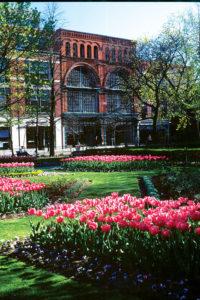
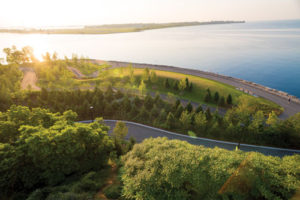
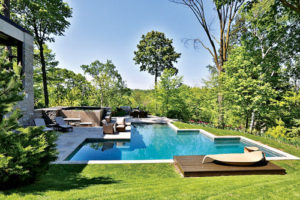
Opportunities:
Brad Johnson: Over the years, designers have changed from using pencils to using digital tools, enabling greater capacity and interchange. But what still remains at the core of any design challenge is under- standing the physical and social context of the project—with the next largest scale and the next, etc.—and what aspects make it matter. This enables landscape architects to acquire meaningful perspectives (including those on climate change) to better guide design decisions and support multidisciplinary collaborations.
Designing rational solutions in response to any challenge, at any scale on, in, under, and over our landscape, is the basic task in the science of landscape architecture. But creating functionality and beauty in ways that stir the blood, make spirits soar, and stimulate contemplation is called art; a transcendent, sometimes elusive goal, but a worthy quest for landscape architects.
Walter Kehm: Whatever I’m working on— an individual residence, the design of a city, or on a park—I’m thinking, what is it going to do to influence human behaviour? What are we doing to enhance wildlife? What do we do that makes people aware of water as a precious commodity—more precious than gold or oil?
Owen Scott: I think we respect our rural landscape much more so than we did 50 years ago, but we still have a heck of a long way to go. There are dozens and dozens of farmsteads and farm buildings and farm landscapes and agricultural landscapes that really belong on the heritage register. Most municipalities don’t include those on their heritage register. But it’s starting to change, as we have more knowledge and more respect for our rural landscapes and rural heritage.
Cecelia Paine: The Landscape Architecture Canada Foundation is an opportunity for landscape architects in Canada to develop a legacy for the profession. The focus of the foundation, which is now 30 years old, is to put our efforts into research, communication, and scholarship that benefit not only the profession of landscape architecture, but what we call the ideals of land- scape architecture. These are the values we hold, many of which are shared by the public and other professionals.
Walter Kehm: I think landscape architects should be explorers. We should be involved with expeditions. What’s happening to the islands that are disappearing in the Pacific? What’s happening with the drought in Africa? I worked in Africa for a year, and I saw how people were adapting to their environment, and how they were trying to keep their cattle alive and keep their families alive. As a landscape architect, you begin to say, what can I do? One of the first things we did was to start tree planting, because the trees were being cut down for firewood. My role as a landscape architect was to replant, and then we found out that a lot of people had eye diseases, such as glaucoma, because there was no groundcover anymore and lots of dust. For the most impoverished people, with the greatest health problems, what can we as landscape architects do? What can we do to help with health, welfare, and human dignity?
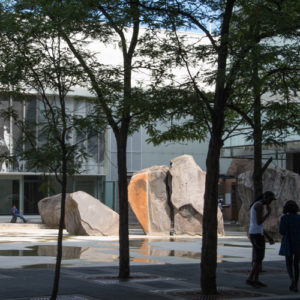
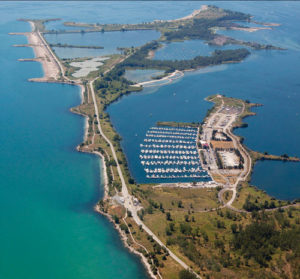
Moving Forward:
Virginia Burt: Motivation is such a personal journey and, for me, it is a journey of the heart. I love the wide range of projects and diversity of challenges each project brings. I am grateful to have found landscape architecture and such a wonderful collection of professionals to work with. Recognition by allied professions of the art and science of our profession and by pioneers such as Cornelia Hahn Oberlander, our first companion of the Order of Canada, keeps me looking forward. To me, there is much to be done to improve and further green our homes, communities, healthcare facilities, cities, and planet—I am excited and thrilled to be a part of the journey.
Steve Moorhead: There are now so many things you can get into as a landscape architect that I don’t think you would have had the opportunity to do in the past. You would not have had the role that you do now. I think that’s the future.
Linda Irvine: I believe that landscape architecture-based mitigation strategies and adaptive measures can help reduce greenhouse gas emissions and temperature increases. Many landscape architects work to manage sustainable and healthy forests to serve as carbon sinks, and others design and implement low-carbon, smart-growth communities that provide for mixed-use neighbourhoods, complete streets, diverse forms of transportation, and ample parks and green spaces. Also, the landscape architectural profession is uniquely positioned to create climate-resilient communities that have the capacity to cope with, and react to, a rapidly changing environment.
Walter Kehm: Landscape architects today have so much to offer because of our background in art, science, and engineering. We are integrative people. We can integrate architectural thinking, we can integrate engineering thinking, and we’re involved up to the top of our hip waders with mental health issues. The current work I’m doing now is on prison reform, and how we can bring horticultural therapy back to prison environments. I can tell you stories about people who are in a prison horticultural program—one individual, a man in his 40s, watched this bulb grow, and he sees a flower for the first time in years, and he says, “Oh my gosh, I’ve done something of value. I created something of value. I created something.” That is the kind of experience that shows how we can introduce people to nature. It’s so vital to our mandate to create humanity, to create conditions for humans to heal, thrive, grow, and be alive.
Carolyn Woodland: Landscape architects and our scientists need to work together on managing our forests, wetlands, and vulnerable ravines not only to sustain our water management systems for resiliency, but to reduce the impact of temperature change, and reduce vulnerabilities to disease and infestation deterioration.
Rob Wright: We need collective intelligence to solve problems. A lot of my educational strategy with students is to get them introduced to other disciplines. I often think of landscape architecture as a discipline of disciplines. We interact with so many different groups, and learning how to do that is really important. Particularly in terms of respecting Indigenous knowledge and people who live on the land. These are really interesting times for us, because our work will shift with that. The great thing about landscape architecture is that we can move in many different directions depending on our interests, right? Which makes it a really interesting profession.
Carolyn Woodland: As a young professional, I thought that good, thoughtful design of our public spaces alone could sell the value of landscape architecture. Today, and with the challenges of city-building before us, good, thoughtful design needs to blend with a political agenda for neighbourhoods and open spaces that contribute to health, social inclusion, and environmental imperatives. Our work as landscapes architects needs to be fueled with creative solutions for urban revitalization and landscape restoration as a foundation for open spaces of the future.
Virginia Burt: Climate change is here, and we are the profession most qualified and most experienced to help. Our time is now, and we can be even more of a solution by writing, publishing, speaking, researching, informing and advocating, and evaluating to produce evidence-based design solutions.
Cecelia Paine: Landscape architects have always dealt with the issues that are coming about because of climate change. We’ve been dealing with stormwater management as part of our profession since its inception. When you think back to Olmsted’s early work in Boston, it was about how to manage stormwater and overflows. Obviously, though, what’s new is the pace at which climate change is happening.
The research that we are doing at the University of Guelph will benefit the profession. It will help us understand better how to design green roofs, for example, and how shade can influence people’s comfort and health. Health professionals are becoming interested in how landscape is designed and how communities are designed, and I think we’ll see stronger ties with health professionals in the future.
What I love about landscape architecture is that you have two living systems that you’re trying to meld. You have the living system of the earth and all the life that it supports, and then you have people and human systems. Putting those two systems together is what has excited me about being a landscape architect.
TODD SMITH, OALA, CONDUCTED VIDEOTAPED INTERVIEWS WITH WALTER KEHM, STEVEN MOORHEAD, CECELIA PAINE, AND OWEN SCOTT, AND THE INTERVIEW (VIA LETTER) WITH ED HOLUBOWICH.
SARAH CULP, OALA, CONDUCTED THE EMAIL INTERVIEW WITH VIRGINIA BURT.
ERIC KLAVER, OALA, CONDUCTED THE IN-PERSON INTERVIEW WITH BRAD JOHNSON.
JAMES MACDONALD NELSON CONDUCTED THE IN-PERSON INTERVIEW WITH ROB WRIGHT.
TRISH CLARKE, OALA, CONDUCTED THE EMAIL INTERVIEW WITH LINDA IRVINE.
RUTHANNE HENRY, OALA, CONDUCTED THE EMAIL INTERVIEW WITH CAROLYN WOODLAND.
